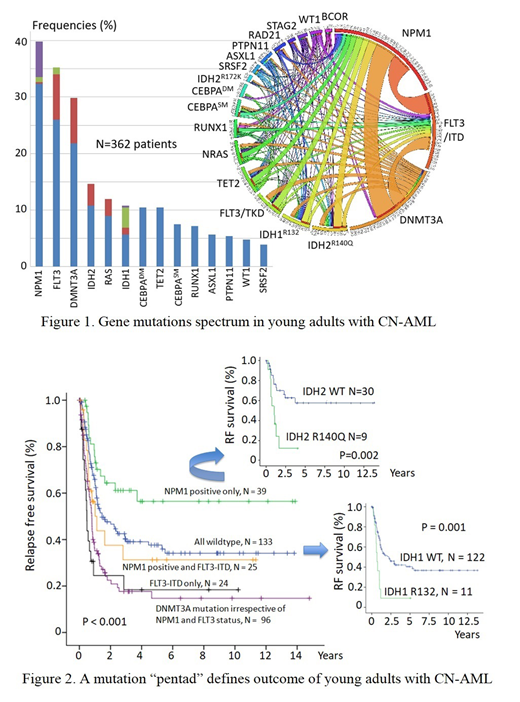Background. Cytogenetically normal acute myeloid leukaemia (CN-AML) occurs in 50% adult AML and is a group of diseases with diverse mutations and distinct clinical outcome. CEBPα, NPM1 and FLT3 mutations that are commonly seen in CN-AML have been incorporated into risk stratification. However, prognostic impacts of other gene mutations and their combinations in this AML subtype have remained unclear. In this study, we examined a cohort of young adults with de novo CN-AML who have received uniform treatment protocol in Hong Kong and identified a mutation pentad that might define their clinical outcome.
Methodology. Young adults (18-60 years old) with de novo CN-AML, diagnosed from 1st August 2003 to 7th August 2018 in 8 regional hospitals in Hong Kong, were included. They received standard "7+3" induction (Daunorubicin 60-90 mg/m2 and Cytarabine 100 mg/m2) followed by up to 4 courses of high dose cytarabine consolidation (Cytarabine 3 gram/m2 for 4-6 doses). Decision on allogeneic haematopoietic stem cell transplantation (HSCT) was based on clinical grounds and gene mutations according to ELN recommendations. Next generation sequencing (NGS) was performed in diagnostic bone marrow (BM) in 362 patients for 36 recurrent mutated genes and analyzed by in-house bioinformatics pipelines. Relapse-free survival (RFS) was defined by the time from first complete remission (CR) to relapse or death and overall survival (OS) by the time from diagnosis to death. Patients were censored at last follow up. Survivals were evaluated by Kaplan-Meier analysis and compared by log-rank test. Multivariate analyses of clinical and genetic parameters were analyzed by Cox-regression. P-values of <0.05 were considered statistically significant.
Results. A total of 436 patients (Male=189; Female=247) were recruited. Their median age of onset was 49 years old (Range 18-60); median presenting white cell counts (WCC) was 21.85x109/L (range 0.25-411x109/L), median circulating blast % was 46% (range 1-99). 416 patients received induction of whom 90.1% achieved CR or CRi (N=375) after 1 (N=268), 2 (N=78) or ≥ 3 courses of induction (N=29). One hundred and sixty three patients received allogeneic HSCT at CR1 (N=102), CR2 (N=51), ≥ CR3 (N=2) and relapsed state (N=8). Eight mutations with ≥ 10% prevalence occurred in 79.8% patients (Figure 1). Univariate analyses showed that mutations of CEBPα, TET2, IDH2-R172K and RAS were not associated with treatment outcome and survival. Five genetic subgroups based on NPM1, FLT3 and DNMT3A mutations could be identified: NPM1 mutation only; NPM1 mutation and FLT3-ITD; All wildtype; FLT3-ITD only; DNMT3A irrespective of NPM1 and FLT3-ITD status. These subgroups showed distinct RFS and OS (Figure 2). Impacts of IDH1-R132 and IDH2-R140Q mutations were evaluated in these 5 subgroups. Interestingly, adverse impacts of IDH1-R132 on RFS and OS were only significant in the all wildtype subgroup and the adverse impact of IDH2-R140Q was only significant for RFS in the NPM1 mutation only subgroup.
Conclusion. A mutation pentad comprising NPM1, FLT3, DNMT3A, IDH1-R132 and IDH2-R140Q seemed to define distinct prognostic subgroups in young adults with de novo CN-AML. A limited gene panel based on this pentad using conventional PCR may provide a practical and cost-effective means to guide post-remission therapy in these patients, especially in places where NGS may not be readily available.
Acknowledgements: SK Yee Medical Foundation; Li Shu Fan Medical Foundation, LKS Faculty of Medicine, University of Hong Kong, Hong Kong Blood Cancer Foundation
Leung:Curegenix: Research Funding; Servier: Research Funding; Merck: Research Funding; Pfizer: Research Funding.
Author notes
Asterisk with author names denotes non-ASH members.


This feature is available to Subscribers Only
Sign In or Create an Account Close Modal